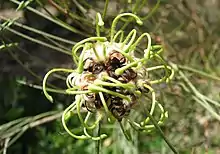Grevillea globosa
Grevillea globosa is a species of flowering plant in the family Proteaceae and is endemic to the south-west of Western Australia. It is a spreading shrub with deeply divided leaves that have three to nine linear lobes, and dense, spherical clusters of pale green, creamy-green and reddish-brown flowers.
| Grevillea globosa | |
|---|---|
 | |
| In Maranoa Gardens | |
| Scientific classification | |
| Kingdom: | Plantae |
| Clade: | Tracheophytes |
| Clade: | Angiosperms |
| Clade: | Eudicots |
| Order: | Proteales |
| Family: | Proteaceae |
| Genus: | Grevillea |
| Species: | G. globosa |
| Binomial name | |
| Grevillea globosa | |
Description
Grevillea globosa is a spreading shrub that typically grows to a height of 1–3 m (3 ft 3 in – 9 ft 10 in) but does not form a lignotuber. Its leaves are erect 80–180 mm (3.1–7.1 in) long and deeply divided with three to nine usually linear lobes, 0.5–1.0 mm (0.020–0.039 in) wide with the edges rolled under, concealing all but the prominent midvein. The flowers are arranged in dense, spherical groups in leaf axils or on the ends of branches on a hairy rachis 5–8 mm (0.20–0.31 in) long. The flowers are pale green to whitish, creamy-green and hairy, turning black as they age, the pistil 13–22 mm (0.51–0.87 in) long, the style greenish. Flowering occurs sporadically throughout the year and the fruit is an oblong follicle 9–12.5 mm (0.35–0.49 in) long.[2][3]
Taxonomy
Grevillea globosa was first formally described by Charles Austin Gardner in 1964 in the Journal of the Royal Society of Western Australia from specimens collected by Fred Lullfitz to the north of Pindar.[4][5] The specific epithet (globosa) means "spherical", referring to the flower clusters.[6]
Distribution and habitat
This grevillea grows in mulga shrubland or mallee woodland between Lake Moore and near Pindar in the Avon Wheatbelt and Yalgoo biogeographic regions of south-western Western Australia.[2][3]
Conservation status
Grevillea globosa is classified as "Priority Three" by the Government of Western Australia Department of Biodiversity, Conservation and Attractions,[3] meaning that it is poorly known and known from only a few locations but is not under imminent threat.[7]
References
- "Grevillea globosa". Australian Plant Census. Retrieved 30 April 2022.
- "Grevillea globosa". Australian Biological Resources Study, Department of Agriculture, Water and the Environment: Canberra. Retrieved 30 April 2022.
- "Grevillea globosa". FloraBase. Western Australian Government Department of Biodiversity, Conservation and Attractions.
- "Grevillea globosa". APNI. Retrieved 30 April 2022.
- Gardner, Charles A. (1964). "Contributiones Florae Australiae Occidentalis, XIII". Journal of the Royal Society of Western Australia. 47 (2): 55. Retrieved 30 April 2022.
- Sharr, Francis Aubi; George, Alex (2019). Western Australian Plant Names and Their Meanings (3rd ed.). Kardinya, WA: Four Gables Press. p. 207. ISBN 9780958034180.
- "Conservation codes for Western Australian Flora and Fauna" (PDF). Government of Western Australia Department of Parks and Wildlife. Retrieved 30 April 2022.
